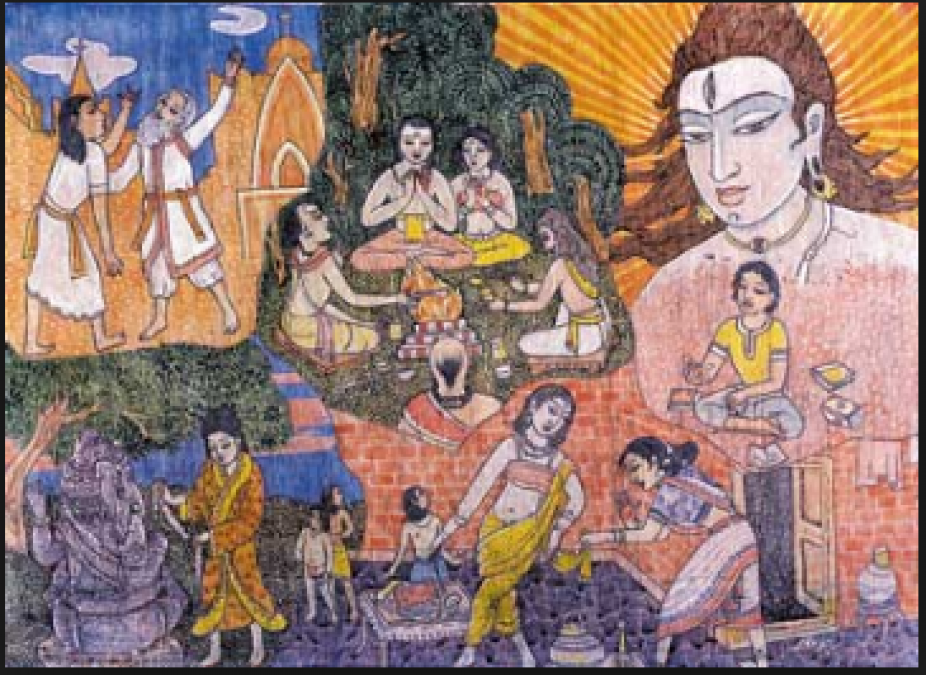
The term Hinduism as a religious label refers to the indigenous religious philosophy of the peoples living in modern day India and the rest of the Indian subcontinent. It is a synthesis of many spiritual traditions of the region and does not have a clearly defined set of beliefs in the same way that other religions do. It is widely accepted that Hinduism is the oldest of the world's religions, but there is no known historical figure credited with being its founder. Hinduism's roots are diverse and are likely a synthesis of various regional tribal beliefs. According to historians, the origin of Hinduism dates back to 5,000 years or more.
The term Hindu is derived from the name of River Indus, which flows through northern India. In ancient times the river was called the Sindhu, but the pre-Islamic Persians who migrated to India called the river Hindu knew the land asHindustan and called its inhabitants Hindus. The first known use of the term Hindu is from the 6th century BCE, used by the Persians. Originally, then, Hinduism was mostly a cultural and geographic label, and only later was it applied to describe the religious practices of the Hindus. Hinduism as a term to define a set of religious beliefs first appeared in a 7th century CE Chinese text.
Timeline: Early History of Hinduism
3000-1600 BCE: The earliest of Hindu practices form their roots with the rise of the Indus Valley civilization in northern Indian sub-continent around 2500 BCE.
1600-1200 BCE: The Aryans are said to invade southern Asia in about 1600 BCE, which would have a lasting influence on Hinduism.
1500-1200 BCE: The earliest Vedas, the oldest of all written scriptures, are compiled about 1500 BCE.
1200-900 BCE: The early Vedic period, during which the main tenets of Hinduism were developed. The earliest Upanishads were written about 1200 BCE.
also read Khanda: All need to known about Sikh Emblem Symbolism
900-600 BCE: The late Vedic period, during which the Brahminical religion, which emphasized ritual worship and social obligations, came into being. During this time, the latter Upanishads are believed to have emerged, giving birth to concepts of karma, reincarnation and moksha (release from Samsara).
500 BCE-1000 CE: The Puranas were written during this time giving rise to the concepts of deities such as the trinity of Brahma, Vishnu, Shiva, and their female forms or Devis. The germ of the great epics of the Ramayana & Mahabharatastarted to form during this time.
5th century BCE: Buddhism and Jainism become established religious offshoots of Hinduism in India.
4th century BCE: Alexander invades western India; Mauryan dynasty founded by Chandragupta Maurya; Composition of Artha Shastra.
3rd century BCE: Ashoka, the Great conquers most of South Asia. Some scholars believe the Bhagavad Gita may have been written in this early period.
2nd century BCE: Sunga dynasty founded.
1st century BCE: Vikrama Era, named after Vikramaditya Maurya, begins. Composition of the Manava Dharma Sashtra or Laws of Manu.
2nd century CE: Composition of the Ramayana completed.
3rd century CE: Hinduism begins a gradual spread to Southeast Asia.
4th to 6th century CE: Widely regarded as the golden age of Hinduism, featuring widespread standardization of Indian legal system, centralized government, and broad spread of literacy. Composition of the Mahabharata completed. Later in this period, devotional Hinduism begins to rise, in which devotees dedicate themselves to particular deities. Devotional Hinduism begins to cause Buddhism to wane in India.
7th century to 12th century CE: This period sees the continued spread of Hinduism to the far reaches of Southeast Asia, even as far as Borneo. But Islamic incursion into India weakens the influence of Hinduism in its land of origin, as some Hindus are violently converted or enslaved. A long period of disunity for Hinduism ensues. Buddhism virtually vanishes from India under Islamic rule.
12th to 16th century CE: India is a land of turbulent, mixed influence between Hindus and Muslims. During this time, however, much unification of Hindu belief and practice occurs, possibly in reaction to Islamic persecution.
17th century CE: The Marathas, a Hindu warrior group, successfully displaces Islamic rulers, but eventually comes into conflict with European imperial ambitions. However, the Maratha empire would pave the way for the eventual resurgence of Hinduism as the principal force in Indian nationalism.
also read Buddhism and Compassion: Teaching and lessons to live life peacefully